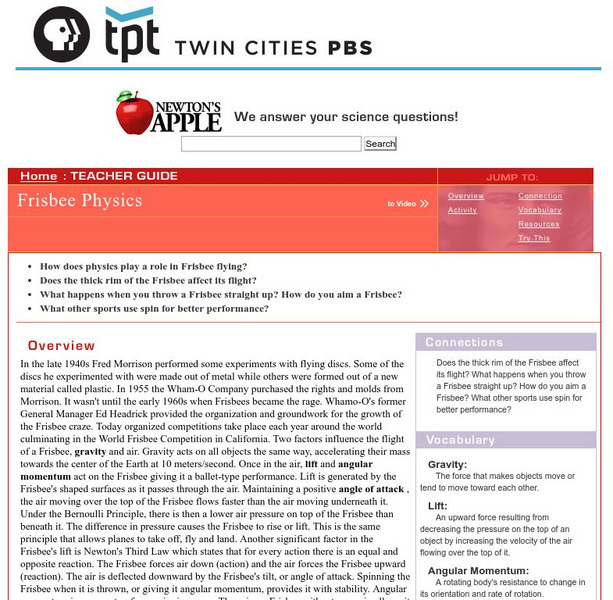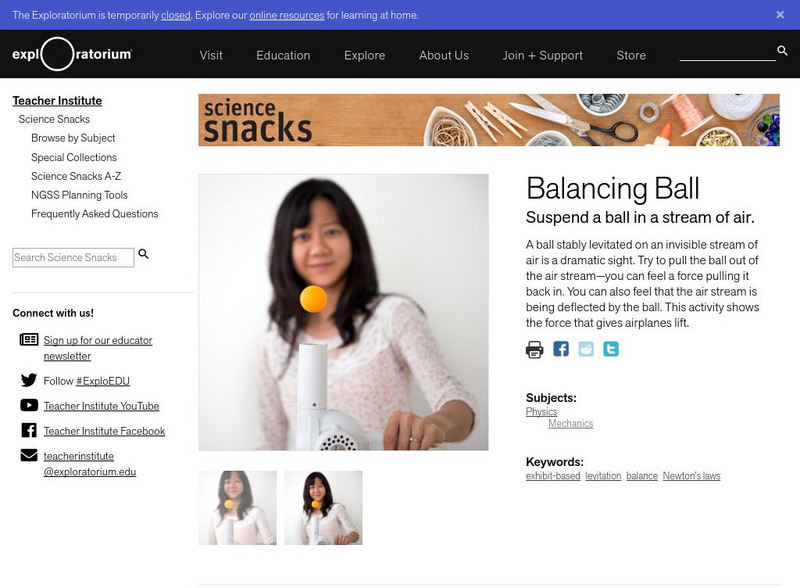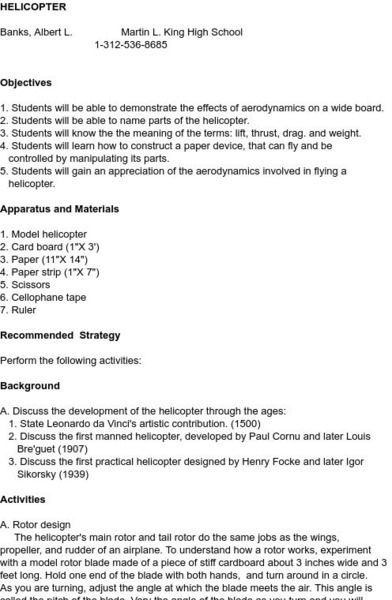PBS
Newton's Apple: Frisbee Physics
This teacher's guide from Public Television's Newton's Apple discusses and illustrates the physics principles governing the flight of a frisbee. Includes teacher lesson plans, activity ideas, discussion questions, and information about...
PBS
Pbs: American Experience: The Wright Stuff
Companion website to the PBS documentary on the Wright Brothers and their contributions to aviation.
PBS
Pbs Teachers: Model Rockets
Explore how the materials and shape of a rocket affect its performance. Watch kids use the scientific method to figure out how to build a model rocket that will reach 1,600 feet.
Other
Easy to Make Paper Airplanes
Have fun making different kinds of flying vehicles. You will learn how to make a paper airplane, helicopter, rocket, blimp, etc.
NASA
Nasa: Beginner's Guide to Aerodynamics
This site from NASA uses a colorful graphic to illustrate why objects reach terminal velocity. Provides equation for the terminal velocity of an object. Graphic is accompanied by a simple explanation.
PBS
Pbs Teachers: Scientific American: Life's Little Questions: How Do Bees Fly?
Build a simple wind tunnel to help formulate and answer questions about how wind influences animals and plants, and then use it to explore why geese fly in formation and to examine why certain plants do not break in strong winds.
PBS
Pbs Teachers: Scientific Breakthroughs in Germany: Flight of the Dragonfly
Emulate the work of a naturalist by making observations of wildlife in local parks. Record field notes, including drawings, photographs, and observations of behavior, on a particular animal or habitat.
Exploratorium
Exploratorium: Science Snacks: Balancing Ball: Suspend a Ball in a Stream of Air
In this lesson plan students learn about air flow using a suspended ball in an air stream.
Treehut
Suzy's World: Aerodynamics
Use this fact sheet to find out what makes things fly with this fact sheet on aerodynamics.
University of Minnesota
The Physics of Flight: Bernoulli's Principle
Discusses air flow around the wing of a plane and its effect upon the lift and drag forces. Focuses on the application of Bernoulli's principle to wing design and the subsequent airfoil shapes.
PBS
Pbs Teachers: Science of Sports: Better Baseball
Investigate how the application of various principles of physics can improve performance in sports. Perform experiments with Bernoulli's Principle and explore the sports-related inventions of a former physics teacher.
Science and Mathematics Initiative for Learning Enhancement (SMILE)
Smile: Lab Activity: Helicopter
The Illinois Institute of Technology lets young scholars investigate the aerodynamics of a helicopter, focusing on the variables which effect the lift, thrust, drag, and weight. Students investigate the effects of aerodynamics on a wide...
Science and Mathematics Initiative for Learning Enhancement (SMILE)
Smile: Lab Work: Come Fly With Me
This site by the Illinois Institute of Technology lets students use a vacuum cleaner hose, ping pong balls, straws and other materials to investigate the effect of moving air upon the surfaces which it hits. Principles are applied as...
Museum of Science
Museum of Science and Industry, Chicago: Activities: Make and Fly a Helicopter
Print and cut out the template for the helicopter. Then experiment with adding and subtracting weight, or changing the shape of the copter or the blades to see what makes it fly best.













